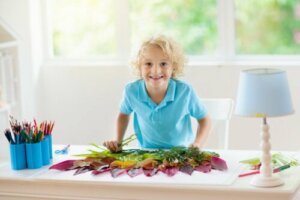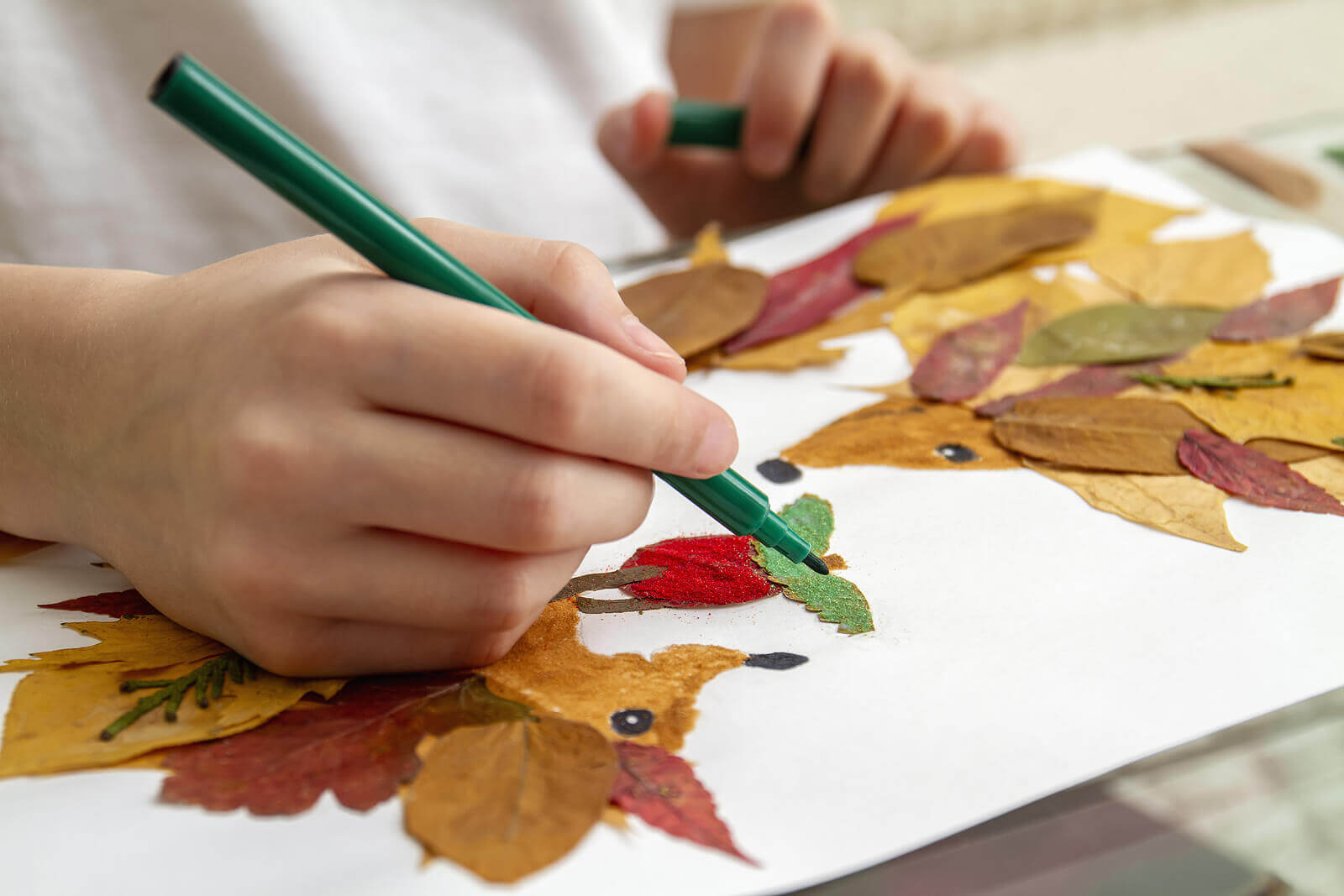Fun Activities for Learning About Plants


Written and verified by the psychologist Ana Couñago
From the first years of schooling, children currently study content related to natural sciences. In this way, they acquire basic knowledge about the environment and living beings. Among many other topics, they start learning about plants, including their characteristics, needs and functions.
All this can be very tedious for little ones, which is why it’s important to take advantage of fun activities for learning about plants. Do you want to know how? Here you’ll find some ideas.
First of all, you have to be clear that it’s important that children understand the world around them. What’s more, they need to build ecological values such as respect, responsibility and care for the environment. This is the only way to achieve a better future in which our planet no longer suffers the terrible consequences of human beings.
“Look deeply into nature and then you will understand everything better.”
– Albert Einstein –
The importance of learning about natural sciences in a practical way
It’s a bit contradictory to study natural sciences only from a theoretical point of view. It’s fundamental to be in contact, in some way, with nature in order to understand everything that happens in it.
Therefore, children should learn in a practical way; in other words, through experimentation, exploration, manipulation and observation of the environment around them.
As a result, children themselves are the main protagonists of their own learning, and they acquire knowledge in a meaningful way. This type of learning also encourages curiosity and discovery of the world in which they live.
In this way, they’ll be able to retain and strengthen the basic concepts related to the natural sciences more easily. This is essential for the future development of new generations, who must be prepared to take care of the planet in a responsible way.
Fun activities for learning about plants
Next, we’re going to propose some activities to carry out with the youngest of the house so that they learn much more about plants and respect for the environment.
Educational videos about plants
A very entertaining and different way to learn about plants is by using videos. This is because receiving information in a visual way facilitates its understanding and retention in memory.
Nowadays, we can find many videos on the internet that deal with the subject of plants and their characteristics. But, here, we’ll recommend videos from the educational platform Smile and Learn.
These educational videos contain some very attractive illustrations, as well as a clear and simple explanation about the parts of the plants and their functions.
Crafts with dry leaves for learning about plants
Another activity that we recommend for working on the theme of plants is to make crafts with dry leaves or flower petals.
To be able to carry out this activity, children have to go for a walk in nature and pick up all those leaves or flowers that have fallen from trees or bushes. Then, they can take advantage of these natural resources and make different crafts with them. For example, collages, decorations, paintings, photo frames… Anything they can think of!

In this way, children can develop their creativity while experimenting the smells and textures of nature.
Planting vegetables in cotton
By planting a bean in cotton, children can better understand the process of plant germination. At the same time, they acquire habits of caring for plants.
To carry out this activity, you need to place a wet piece of cotton inside a glass or a plastic container and place a legume on top. You can use a lentil, a white bean, a chickpea, etc. Then, cover the legume with another piece of wet cotton. In this way, children can observe how their plant grows day after day.
Did you like any of these activities for learning about plants? What are you waiting for to put them into practice with your children? They’ll love to learn wonderful things about plants and you’ll be delighted to see them enjoy themselves as they do.
From the first years of schooling, children currently study content related to natural sciences. In this way, they acquire basic knowledge about the environment and living beings. Among many other topics, they start learning about plants, including their characteristics, needs and functions.
All this can be very tedious for little ones, which is why it’s important to take advantage of fun activities for learning about plants. Do you want to know how? Here you’ll find some ideas.
First of all, you have to be clear that it’s important that children understand the world around them. What’s more, they need to build ecological values such as respect, responsibility and care for the environment. This is the only way to achieve a better future in which our planet no longer suffers the terrible consequences of human beings.
“Look deeply into nature and then you will understand everything better.”
– Albert Einstein –
The importance of learning about natural sciences in a practical way
It’s a bit contradictory to study natural sciences only from a theoretical point of view. It’s fundamental to be in contact, in some way, with nature in order to understand everything that happens in it.
Therefore, children should learn in a practical way; in other words, through experimentation, exploration, manipulation and observation of the environment around them.
As a result, children themselves are the main protagonists of their own learning, and they acquire knowledge in a meaningful way. This type of learning also encourages curiosity and discovery of the world in which they live.
In this way, they’ll be able to retain and strengthen the basic concepts related to the natural sciences more easily. This is essential for the future development of new generations, who must be prepared to take care of the planet in a responsible way.
Fun activities for learning about plants
Next, we’re going to propose some activities to carry out with the youngest of the house so that they learn much more about plants and respect for the environment.
Educational videos about plants
A very entertaining and different way to learn about plants is by using videos. This is because receiving information in a visual way facilitates its understanding and retention in memory.
Nowadays, we can find many videos on the internet that deal with the subject of plants and their characteristics. But, here, we’ll recommend videos from the educational platform Smile and Learn.
These educational videos contain some very attractive illustrations, as well as a clear and simple explanation about the parts of the plants and their functions.
Crafts with dry leaves for learning about plants
Another activity that we recommend for working on the theme of plants is to make crafts with dry leaves or flower petals.
To be able to carry out this activity, children have to go for a walk in nature and pick up all those leaves or flowers that have fallen from trees or bushes. Then, they can take advantage of these natural resources and make different crafts with them. For example, collages, decorations, paintings, photo frames… Anything they can think of!

In this way, children can develop their creativity while experimenting the smells and textures of nature.
Planting vegetables in cotton
By planting a bean in cotton, children can better understand the process of plant germination. At the same time, they acquire habits of caring for plants.
To carry out this activity, you need to place a wet piece of cotton inside a glass or a plastic container and place a legume on top. You can use a lentil, a white bean, a chickpea, etc. Then, cover the legume with another piece of wet cotton. In this way, children can observe how their plant grows day after day.
Did you like any of these activities for learning about plants? What are you waiting for to put them into practice with your children? They’ll love to learn wonderful things about plants and you’ll be delighted to see them enjoy themselves as they do.
All cited sources were thoroughly reviewed by our team to ensure their quality, reliability, currency, and validity. The bibliography of this article was considered reliable and of academic or scientific accuracy.
- Arrieta Miranda, A. (2021). Importancia de los Germinados Para el Consumo Humano. https://repositorio.udes.edu.co/server/api/core/bitstreams/360e06e6-ea5b-4857-acf2-efbfe71698b6/content
- Corominas, M. A., & Torres, M. C. (2000). Alimentos vivos: La carga enzimática de los alimentos crudos y su función nutricional. Natura Medicatrix: Revista médica para el estudio y difusión de las medicinas alternativas, (60), 6-13. https://dialnet.unirioja.es/servlet/articulo?codigo=4989585
- González-Souto, M. T. (2016). Ciencia y experimentación en Segundo Ciclo de Educación Infantil. Descubrir el agua (Bachelor’s thesis). https://reunir.unir.net/bitstream/handle/123456789/3562/GONZALEZ%20SOUTO%2c%20MARIA%20TERESA.pdf?sequence=1&isAllowed=y
- López de Frutos, E., & Sgaramella, C. (2021). Banco de semillas. Propuesta de creación entre la imaginación y la pedagogía. ANIDA 1. Revista de arte y escuela, (1), 1-14. https://riunet.upv.es/bitstream/handle/10251/189818/LopezSgaramella%20-%20Banco%20de%20semillas%20Propuesta%20de%20creacion%20entre%20la%20imaginacion%20y%20la%20pedagogia.pdf?sequence=1&isAllowed=y
- Morales, M. N., Bugdud, A. T., & Aguilar, N. Á. (2012). Evolución e importancia de la Educación Medioambiental: su implicación en la educación superior. Educación y futuro: revista de investigación aplicada y experiencias educativas, (26), 155-174. https://dialnet.unirioja.es/descarga/articulo/3923982.pdf
- Rodríguez Salinas, M. E. (2021). El desarrollo de la observación científica en el preescolar a través de una secuencia didáctica sobre la morfología de las plantas de la escuela (Master’s thesis, Tesis (MC)–Centro de Investigación y de Estudios Avanzados del IPN Unidad Monterrey). https://repositorio.cinvestav.mx/bitstream/handle/cinvestav/3207/SSIT0016425.pdf?sequence=1
This text is provided for informational purposes only and does not replace consultation with a professional. If in doubt, consult your specialist.








